Here it is!!! Our first ever video, and certainly not the last - please let me know what you guys thought, this took a lot of work, but I feel the end result was worth it!
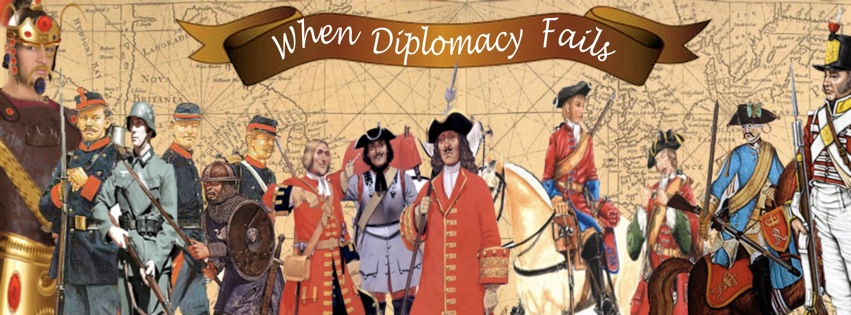
When Diplomacy Fails is a weekly podcast covering the buildup to, break out of and consequences of various conflicts throughout history. If you have the funds, a donation would be much appreciated, but if not, please support in the other ways by: iTunes= rate and review the podcast Facebook= like the Fb page or join the HISTORY PODCASTS group Email= talk to me directly wdfpodcast@hotmail.com TALK= Tell your friends about me! Spread the word today!
Saturday 25 June 2016
Thursday 16 June 2016
1916 And All That
It's been a long-ass road history friends. We've had emotional music, tense final moments and hopefully stirring examples of why one should always always refrain from plucking historical events out of the sky. 1916 was a personal journey for me, but it was also one of discovery, since I realised only half way in how strongly I really felt about my central thesis for the project. My central thesis, to refresh your memory, basically revolved around the fact that human life is more important than an idea, and that 1916 was wrong because the aura of the 'republican idea' has since been upheld as more important than the numerous lives lost since 1916 - be they during the Rising, the War of Independence, the Civil War or the Troubles.
The hardest part during this miniseries for me was trying to reconcile how upset I was at the way people view 1916 and how wrong it all was with the fact that Ireland should have been independent in 1916, and that Britain had no right to rule over her at all. At all. I tried to dress it up, I tried to make it seem like no big deal, but it was. Ireland was under foreign rule in 1916 - to state otherwise would compromise my claim that I am in fact a patriot and believe that Ireland is a nation, and has been for some time. What I learned though, was that reconciling the two objects - Ireland under foreign rule, and my hatred for the revolt which overthrew that foreign rule - wasn't as hard as I'd expected.
You see, historians often complain that we as modern day humans see things that happened in the past from our own point of view. When we do this, they claim, we also apply our own moral standards to their actions in the process, and this isn't fair. It isn't fair because we forget how many different pressures were acting on the individuals in question that we end up judging; we forget that their world was very different to ours. To me, the penny dropped when I realised something critical - perhaps the most critical thing that I realised during the course of this miniseries. I realised that I wasn't applying my own moral standards at all, I was merely echoing those of 1916, because in 1916, just like personally in my own mind right now, the 1916 Rising was an event that was wholly condemned, that is, by the majority of the Irish people.
Such a fact jumps out at one from the pages and record of history, and it makes a lie of the modern claim that the rising freed Ireland from British tyranny. Even if Ireland became independent in the years that followed the rising, it did so at a distinct disadvantage, because its entire journey to independence after 1916 was completely unnatural - not only that, but it was totally unrepresentative of all the Irish history that had come before that. To summarise all that I've just said, my efforts to reconcile Ireland's justifiable call for sovereignty with my hatred of violence were made all the more easier by the fact that 1916 was condemned by the majority of people in Ireland in 1916. What that means is, I'm not applying my moral standards, I'm merely examining the evidence of the era and making a judgement based on that evidence; if Ireland as a whole would have condemned those that acted in 1916 for all the reasons that they did, then why shouldn't we?
That, essentially, was how I reached the conclusions that I reached. It is far easier to argue in terms of moral principles when I know full well that these arguments would have carried weight in Ireland in 1916. Therefore, I instead was able to judge that Ireland has since been shaped not by the majority opinion, but by the minority. The violent revolutionary republicanism which for so long had been seen as the fringe view in Irish society was embraced in a rebellious Irish atmosphere post-Rising, because the British act of execution vindicated all that the rebels had said and done.
It was too hard to go back once the final shots were fired at James Connolly and Sean McDermott in mid-May 1916. With every bullet Britain had proved itself less tactful and more out of touch than anyone could have previously anticipated. It changed everything to see these men die in front of British bullets, and those that chose to sign the proclamation knew full well that it would. They knew that Britain, consumed by its war on the continent and unable to afford threats to its prestige or security, would take the harshest measures possible. The martyrs also understood that this would inspire Irish people to take up their challenge and renew the fight. To me this makes the actions of the rebel leaders doubly wrong, because not only were they prepared to launch a revolt that nobody wanted in the center of the capital, thus endangering Irish civilians, but they were prepared as well to doom their countrymen to a hopeless military goal of separation from the greatest Empire in the world at that time, through force of arms.
This is why I have such a problem with how romanticised the lives and deaths of the martyrs now are. Had they really cared for Irish people, they would never have acted. You can make all the excuses you like for the need to place it in context, but what I learned from doing this is that the context says they were wrong. The context says that these rebels acted against the majority in the name of a hopeless goal that they knew could never be achieved, yet they set their nation up to achieve it, with every failed campaign and every wasted life that has been lost in Ireland since being on their hands. To this, many of my peers would passionately argue that the rebels had been brave, and that the British had been brutal.
To these quips I would say 'you're dead right!' but at the same time, such facts were also well known before the rising as well. It was perfectly appreciated before the rising ripped through Dublin that a secret organisation containing hardened Irish republicans existed - they had their own newspaper network and would have had their share of renowned figures after all. The whole reason Irish politicians had for so long endured the shortcomings of the Westminster system was because they were making the best of a bad situation - British rule may have been illegitimate and it may have been based on force, but Irish MPs appreciated at the same time that to resist such a system in kind was pointless - what could the less than 4 million Irish do against an Empire in excess of 100 million? Militarily, nothing, but politically, a great deal.
British rule was wrong, it was unfair and contradictory for a British Empire that liked to think and present itself as a morally principled and liberal society, where men were to be treated equally and slavery was to be abhorred. I have stated such things till I'm blue in the face, but where both my peers and some historians, and many public figures have then gone on to present the 1916 Rising as a response to this, I would stop. I would stop because if we continue and say that Ireland in 1916 was merely reacting to the unfairness of British rule, that it was merely freeing itself from the chains of oppression, then we perpetuate a lie. If this line of reasoning were true, then it wouldn't have been a Rising, but a revolution that took place in 1916, and Irish people wouldn't have joined the British Army in droves at the outbreak of war in 1914. Irish people wouldn't have invested their faith, time, energy and other significant resources into the political process.
They wouldn't have seen themselves as part of the Empire. They wouldn't have desired Home Rule, but they did. And they did because they were realistic, and they viewed the fringe section of the country that advocated a violent struggle to achieve Irish independence with utter scorn, since they knew where such ideologies had led Ireland in the past - look at the 1798, 1803, 1848 or 1867 revolts for examples. The point is, just like we can argue and say that British rule was historically unfair and unjust in Ireland, we can also argue with significant evidence to back us up, that Irish people as a whole supported and invested their time into the curious Anglo-Irish arrangement that existed by 1916. Consequently, this meant that Irish people, whether we like to admit it or not, were largely content to remain within the British Empire, or at least were willing to make use of the political process to bring about change in Ireland - as they had done for the past three generations.
When we look back at Ireland in 1916, we are doing so with the benefit of 100 years of history and over 80 years of legislative independence. Our views are thus molded by the perception that we believe Ireland shouldn't have taken part in the Westminster system or should have launched a revolution to free itself, but this is a view which is both a-historical, and morally wrong. Why should a largely contented Irish country wage a hopeless war against the larger power. Britain was not killing citizens at random, it was not locking Irish men and women up in cages, it was not silencing its pro-Irish or even anti-war press. It was running an Empire, for sure, but this was an Empire that Irish people as a whole were content to take part in the administration of, and invest their resources in. To state otherwise, unfortunately for nationalist historians, is factually incorrect.
Such incendiary claims are not being made for the mere craic - instead I'm stating this so that you understand why I don't support the Rising OR what it claimed to stand for. The reason why I don't support it, in plain terms, is because it killed people, doomed Ireland to suffer, and went against the express wishes of the majority. I cannot state my case any clearer than that, so hopefully after listening to all of what I've let loose in my conclusion, you understand where I'm coming from. Any Irish fans that have been led here, I hope you appreciate what I've done, and that even if you're not convinced, you are willing to admit that more than one side to the 1916 Rising exists. For too long our country has suffered under the weight of the doctrine that launched 1916. It has suffered because such an ideology was never meant to acquire such a following, because it wasn't compatible with the reality of Ireland on the ground.
This is a beautiful country. The people are incredible (how about those Irish Euros fans ay?), the weather is shite and the scenery is inspiring. You don't need the events of the Rising or the violent militarism which followed it to appreciate Ireland. All you need is an open mind, an understand heart, and a refill of your pint. Let me get that for your friend, you've come a long way.
So thanks for reading, and if you've made it this far and listened to all 20 of the episodes, thanks ever so much for listening. I hope you tell your friends and fam what I did here, and I hope it all gave you pause for thought as well. WDF will be taking a small break, probably until 1st August at the very latest, since I am in bad need of a rest from the stress that this has been, but also because I need to plan the next phase of WDF, and its next project. We won't be totally silent here, and you should expect a TALK episode to round this up, and celebrate the fact that we are now over FOUR YEARS OLD! Woohoo!
A little hint for both objects - my plan and dream is that soon, you won't be merely listening to When Diplomacy Fails, you'll be watching as well. As for what we'll be doing next, let's just say you've all been asking for years, and I've been putting it off for just as long. In case you didn't know, Britain Goes To War will be put on hold, until that aforementioned phase is over. I hope I'll see you there.
Super handy map of the positions taken during the 1916 Rising. Note their spread out nature, later put down to lack of manpower, but which most historians put down to harebrained tactics nowadays.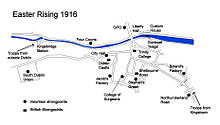

The hardest part during this miniseries for me was trying to reconcile how upset I was at the way people view 1916 and how wrong it all was with the fact that Ireland should have been independent in 1916, and that Britain had no right to rule over her at all. At all. I tried to dress it up, I tried to make it seem like no big deal, but it was. Ireland was under foreign rule in 1916 - to state otherwise would compromise my claim that I am in fact a patriot and believe that Ireland is a nation, and has been for some time. What I learned though, was that reconciling the two objects - Ireland under foreign rule, and my hatred for the revolt which overthrew that foreign rule - wasn't as hard as I'd expected.
Augustine Birrell was Britain's man on the ground by 1916. As Ireland's Chief Secretary, he had been in place for over ten years by the time the rising broke out. In that time he had built up valuable connections with the likes of John Redmond, and had come to respect Irish customs. He appreciated the need to let the Irish be, and create their own cultural and linguistic organisations. He was the most notable political casualty of the Rising in Britain, but certainly not the last.

John Redmond, leader of the Irish Parliamentary Party since 1906 and its - in theory - most successful activist, since it was he who capitalised upon events in Britain to push through the Third Home Rule Bill in 1914, only to see it postponed by the outbreak of WW1.
Arthur Griffith, one of Ireland's political giants before the Rising, was the founding member of Sinn Fein in 1905 and a critical Irish politician in the years that followed. His impact on Irish history was overshadowed by the massive change which resulted in his party following the Rising, when the Sinn Feinn Rebellion transformed his movement from a small alternative political party to a revolutionary republican party.

Michael Davitt, former IRB member, founder of the Land League, friend of Parnell and all round important Irish guy. He was an example of the kind of man Ireland should have looked up in the 20th century. I still believe today that more people could learn from his example.

You see, historians often complain that we as modern day humans see things that happened in the past from our own point of view. When we do this, they claim, we also apply our own moral standards to their actions in the process, and this isn't fair. It isn't fair because we forget how many different pressures were acting on the individuals in question that we end up judging; we forget that their world was very different to ours. To me, the penny dropped when I realised something critical - perhaps the most critical thing that I realised during the course of this miniseries. I realised that I wasn't applying my own moral standards at all, I was merely echoing those of 1916, because in 1916, just like personally in my own mind right now, the 1916 Rising was an event that was wholly condemned, that is, by the majority of the Irish people.
Nobody would be able to say with a straight face that the Irish weren't treating woefully by the British at times. Here is a painting/sketch by Henry Doyle c.1868, depicting the leaving of Irish emmigrants for the new world, as they were forced to abandon their homeland for better opportunities elsewhere. Tearful scenes were inevitable, but those that left would make an indelible mark on the wider world, be it in culture, literature, architecture or science. 

William Butler Yeats, Ireland's foremost playwright and influential figure. His work 'Easter 1916', encapsulated everything that had occurred in the rising, from Yeats' own difficulties in reconciling it with his nationalism, to his personal abhorring of the violence therein.

Such a fact jumps out at one from the pages and record of history, and it makes a lie of the modern claim that the rising freed Ireland from British tyranny. Even if Ireland became independent in the years that followed the rising, it did so at a distinct disadvantage, because its entire journey to independence after 1916 was completely unnatural - not only that, but it was totally unrepresentative of all the Irish history that had come before that. To summarise all that I've just said, my efforts to reconcile Ireland's justifiable call for sovereignty with my hatred of violence were made all the more easier by the fact that 1916 was condemned by the majority of people in Ireland in 1916. What that means is, I'm not applying my moral standards, I'm merely examining the evidence of the era and making a judgement based on that evidence; if Ireland as a whole would have condemned those that acted in 1916 for all the reasons that they did, then why shouldn't we?
Gladstone, depicted here looking over his shoulder as an armed, rough looking member of the Land League seems to threaten him with violence. Gladstone wasn't the only British politician to be lampooned by the Conservative Press in the late 19th century for failing to stand up for the aristocratic landowners against the farmers. The reality was, of course, such farmers held the moral high ground. It is highly likely that even if Gladstone hadn't been pressured by the grassroots movements that sprang up, he would have relented from the moral persuasions of their cause.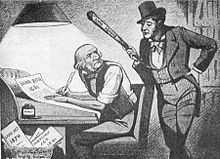

The rent strike launched by the Land League was a serious escalation of their campaign for fairer rents and an end to the absentee landlord system in Ireland would be its eventual result. Through the political process, and with the avid support of high profile Irish MPs like Charles Stewart Parnell and Michael Davitt, Ireland was able to advance itself towards prorgess and better lives for its people.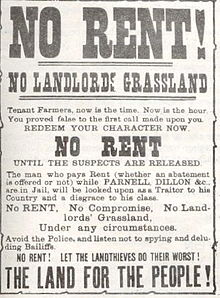
That, essentially, was how I reached the conclusions that I reached. It is far easier to argue in terms of moral principles when I know full well that these arguments would have carried weight in Ireland in 1916. Therefore, I instead was able to judge that Ireland has since been shaped not by the majority opinion, but by the minority. The violent revolutionary republicanism which for so long had been seen as the fringe view in Irish society was embraced in a rebellious Irish atmosphere post-Rising, because the British act of execution vindicated all that the rebels had said and done.
Big Jim Larkin's statue at the top of O'Connell Street is big enough to give one pause for thought. The problem is that though many may pass by it today, few actually understand the significance of the man depicted here or what he actually fought to achieve. They would be able to mention the name of James Connolly far easier, when it was Larkin who Connolly originally drew such inspiration from.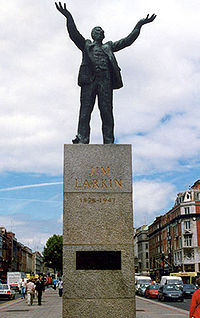

It was too hard to go back once the final shots were fired at James Connolly and Sean McDermott in mid-May 1916. With every bullet Britain had proved itself less tactful and more out of touch than anyone could have previously anticipated. It changed everything to see these men die in front of British bullets, and those that chose to sign the proclamation knew full well that it would. They knew that Britain, consumed by its war on the continent and unable to afford threats to its prestige or security, would take the harshest measures possible. The martyrs also understood that this would inspire Irish people to take up their challenge and renew the fight. To me this makes the actions of the rebel leaders doubly wrong, because not only were they prepared to launch a revolt that nobody wanted in the center of the capital, thus endangering Irish civilians, but they were prepared as well to doom their countrymen to a hopeless military goal of separation from the greatest Empire in the world at that time, through force of arms.
This monument to Parnell and Parnell Square are both the legacy of the tireless work of Parnell. Had he died by British bullets rather than illness caused by the stress and difficulties of his intense job, his statue may be bigger, his work more well known, and his life seen as more important. Instead his struggles have been overshadowed by the deaths of the martyrs, men who spurned Parnell's example and resorted to violence, rather than give Parnell's political legacy a chance.

This is why I have such a problem with how romanticised the lives and deaths of the martyrs now are. Had they really cared for Irish people, they would never have acted. You can make all the excuses you like for the need to place it in context, but what I learned from doing this is that the context says they were wrong. The context says that these rebels acted against the majority in the name of a hopeless goal that they knew could never be achieved, yet they set their nation up to achieve it, with every failed campaign and every wasted life that has been lost in Ireland since being on their hands. To this, many of my peers would passionately argue that the rebels had been brave, and that the British had been brutal.
Ireland's population since 1600. Note the extreme drop off after its peak in the middle of the 1800s. This was the famine, and it was from that Great and terrible famine that so much of Irish history was shaped.

To these quips I would say 'you're dead right!' but at the same time, such facts were also well known before the rising as well. It was perfectly appreciated before the rising ripped through Dublin that a secret organisation containing hardened Irish republicans existed - they had their own newspaper network and would have had their share of renowned figures after all. The whole reason Irish politicians had for so long endured the shortcomings of the Westminster system was because they were making the best of a bad situation - British rule may have been illegitimate and it may have been based on force, but Irish MPs appreciated at the same time that to resist such a system in kind was pointless - what could the less than 4 million Irish do against an Empire in excess of 100 million? Militarily, nothing, but politically, a great deal.
The reality today is that Ireland is split between the North and the rest. The North contains individuals who wish to remain part of the United Kingdom, and thus London has since 1920 continued to administer this part of the island of Ireland separately from the rest. With the Good Friday Agreement of 1998, it was agreed that only through the demonstrated wish of the majority in the North, could this status quo change, and Ireland be reunified. Debates rage on today over whether such an eventuality could ever take place; whether the weight of history will prove too great or whether common bonds and aims will win out. Whatever happens, violence will thankfully hold no say in the deliberations that precede or follow such events. Ireland seems to have, mercifully, left that part of its past behind her, and hopefully for good.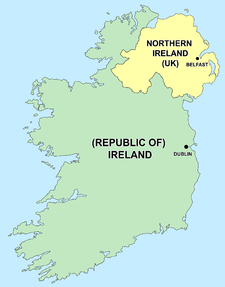
British rule was wrong, it was unfair and contradictory for a British Empire that liked to think and present itself as a morally principled and liberal society, where men were to be treated equally and slavery was to be abhorred. I have stated such things till I'm blue in the face, but where both my peers and some historians, and many public figures have then gone on to present the 1916 Rising as a response to this, I would stop. I would stop because if we continue and say that Ireland in 1916 was merely reacting to the unfairness of British rule, that it was merely freeing itself from the chains of oppression, then we perpetuate a lie. If this line of reasoning were true, then it wouldn't have been a Rising, but a revolution that took place in 1916, and Irish people wouldn't have joined the British Army in droves at the outbreak of war in 1914. Irish people wouldn't have invested their faith, time, energy and other significant resources into the political process.
Edward Carson's Solemn League and Covenant in 1912 demonstrated that a great divide existed in Ireland over the nature of its identity. Whether it was to be London or Dublin that determined the island's future, furious debate could not decide. From the events of 1912 did the eventual partition of Ireland spring, but historians have since argued both for and against the idea that 1916 ensured partition took place. We can never know for sure, but without 1916 the region certainly would never have played host to the Troubles - the horrendous tit for tat series of killings, bombings and rampages which pitted Unionist against Republican, with everyone else caught in between.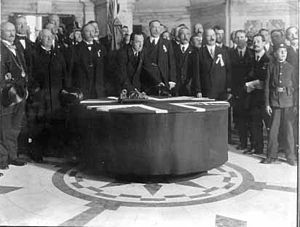

They wouldn't have seen themselves as part of the Empire. They wouldn't have desired Home Rule, but they did. And they did because they were realistic, and they viewed the fringe section of the country that advocated a violent struggle to achieve Irish independence with utter scorn, since they knew where such ideologies had led Ireland in the past - look at the 1798, 1803, 1848 or 1867 revolts for examples. The point is, just like we can argue and say that British rule was historically unfair and unjust in Ireland, we can also argue with significant evidence to back us up, that Irish people as a whole supported and invested their time into the curious Anglo-Irish arrangement that existed by 1916. Consequently, this meant that Irish people, whether we like to admit it or not, were largely content to remain within the British Empire, or at least were willing to make use of the political process to bring about change in Ireland - as they had done for the past three generations.
The ruined corner of Sackville Street just after the Rising. Note Nelson's Pillar in the background.

When we look back at Ireland in 1916, we are doing so with the benefit of 100 years of history and over 80 years of legislative independence. Our views are thus molded by the perception that we believe Ireland shouldn't have taken part in the Westminster system or should have launched a revolution to free itself, but this is a view which is both a-historical, and morally wrong. Why should a largely contented Irish country wage a hopeless war against the larger power. Britain was not killing citizens at random, it was not locking Irish men and women up in cages, it was not silencing its pro-Irish or even anti-war press. It was running an Empire, for sure, but this was an Empire that Irish people as a whole were content to take part in the administration of, and invest their resources in. To state otherwise, unfortunately for nationalist historians, is factually incorrect.
The skeleton of the Metropole Hotel, one of the buildings used by the rebels during the Rising, gutted by fire and shelling during the course of that event. 

Such incendiary claims are not being made for the mere craic - instead I'm stating this so that you understand why I don't support the Rising OR what it claimed to stand for. The reason why I don't support it, in plain terms, is because it killed people, doomed Ireland to suffer, and went against the express wishes of the majority. I cannot state my case any clearer than that, so hopefully after listening to all of what I've let loose in my conclusion, you understand where I'm coming from. Any Irish fans that have been led here, I hope you appreciate what I've done, and that even if you're not convinced, you are willing to admit that more than one side to the 1916 Rising exists. For too long our country has suffered under the weight of the doctrine that launched 1916. It has suffered because such an ideology was never meant to acquire such a following, because it wasn't compatible with the reality of Ireland on the ground.
It was here that the vast majority of those killed following the Rising were executed. Kilmainham Gaol, Dublin. Nowadays, tours of the building and final moments of those rebel martyrs can be experienced, as part of the Irish government's attempts to bring the rising to people on a human level.

This is a beautiful country. The people are incredible (how about those Irish Euros fans ay?), the weather is shite and the scenery is inspiring. You don't need the events of the Rising or the violent militarism which followed it to appreciate Ireland. All you need is an open mind, an understand heart, and a refill of your pint. Let me get that for your friend, you've come a long way.
TOP TO BOTTOM Michael O'Hanrahan, Cornelius 'Con' Colbert and Edward Daly - rebels shot by the British for their roles in the 1916 rising.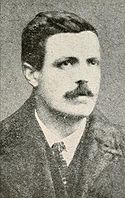
So thanks for reading, and if you've made it this far and listened to all 20 of the episodes, thanks ever so much for listening. I hope you tell your friends and fam what I did here, and I hope it all gave you pause for thought as well. WDF will be taking a small break, probably until 1st August at the very latest, since I am in bad need of a rest from the stress that this has been, but also because I need to plan the next phase of WDF, and its next project. We won't be totally silent here, and you should expect a TALK episode to round this up, and celebrate the fact that we are now over FOUR YEARS OLD! Woohoo!
Patrick Pearse, the man I spent the most time analysing during this miniseries, and arguably the personification of the 1916 Rising. What follows are the images of the other 6 signatories of the Proclamation of the Irish Republic.

Thomas McDonagh, Pearse's good friend and fellow teacher and Irish language enthusiast, before his radicalisation. He had been present for the founding of the Irish Volunteers in late 1913 and had favoured constitutionalist politics, before becoming more radicalised by his association.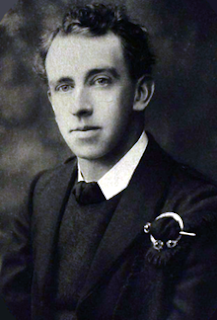

Joseph Plunkett, romanticist, poet and literary man responsible for travelling to Germany alongside Roger Casement in the hopes of forming an Irish brigade out of Irish POWs.

Tom Clarke, perhaps the forgotten man of the Rising since it was he more than any other that directed its course. Responsible for establishing both the IRB's Military Council, as well as directing its Executive alongside Sean McDermott, Clarke was one of the first three executed alongside MacDonagh and Pearse on 3rd May 1916, following decades of anti-British activities.

Sean McDermott/MacDiarmaida, the other man on the three man executive, and Tom Clarke's second. He was the last executed by firing squad, alongside James Connolly, on 12th May 1916.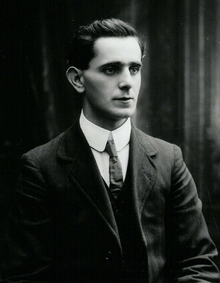

James Connolly c.1900. Connolly is probably the second most famous signatory and martyr of 1916. His beliefs are difficult to account for nowadays, since he seemed to have been plagued by contradictions, undergoing conversion to a revolutionary republican cause despite his avid Socialism. 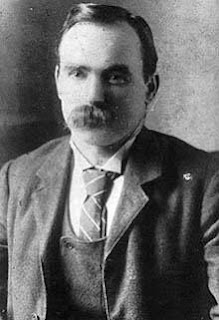

Finally, we have Eamonn Ceannt/Edward Kent, another signatory and a critical thinker and commander at the time of the Rising. Ceannt was known to possess immense charisma and charm, while also demanding the utmost discipline from his men at all times. He would be stationed at the South Dublin Union for the duration of the rising, where harsh fighting would ensue.

A little hint for both objects - my plan and dream is that soon, you won't be merely listening to When Diplomacy Fails, you'll be watching as well. As for what we'll be doing next, let's just say you've all been asking for years, and I've been putting it off for just as long. In case you didn't know, Britain Goes To War will be put on hold, until that aforementioned phase is over. I hope I'll see you there.
The two symbols which held such credence for republicans since the events of 1916. The Republican flag which was erected over the top of the General Post Office HQ on 24th April 1916, and the Proclamation of the Irish Republic which had been read out that afternoon by a nervous Patrick Pearse. Everything that followed in Irish history has hearkened back, at least to some extent, to that piece of paper, which declared that an Irish Republic had come to pass.

***************
Bibliography.
Where possible, every attempt has been made to give credit to the author/historian. I am indebted to the following works, without which the 1916 Miniseries would never have gone ahead. If you wish to inquire about any of them, please contact me with any questions you may have, I'd be happy to help where I can. The following the list has been exhaustively constructed, so I hope it will be useful to you if you ever decide to do such a project as this one.
Academic Articles; (downloaded from JSTOR.org with membership access).
·
Beiner, Guy. ‘Between Trauma and Triumphalism:
The Easter Rising, the Somme, and the Crux of Deep Memory in Modern Ireland’. Journal of British Studies, Vol. 46,
No. 2 (April 2007), pp. 366-389.
·
Bhreathneach-Lynch, Síghle. ‘Revisionism, the
Rising, and Representation’. New Hibernia
Review / Iris Éireannach Nua, Vol. 3, No. 1 (Spring, 1999), pp. 82-96.
·
Boyce, David G. ‘British Opinion, Ireland, and
the War, 1916-1918’. The Historical Journal,
Vol. 17, No. 3 (Sep., 1974), pp. 575-593.
·
Campbell, Malcolm. ‘Emigrant Responses to War
and Revolution, 1914-21: Irish Opinion in the United States and Australia’. Irish Historical Studies, Vol. 32, No.
125 (May, 2000), pp. 75-92.
·
Chandler, James. ‘Cinema, History, and the
Politics of Style: Michael Collins and The Wind that Shakes the Barley’. Field Day Review, Vol. 7 (2011), pp.
102-121.
·
Chapman, Wayne K. ‘Joyce and Yeats: Easter 1916
and the Great War’. New Hibernia Review /
Iris Éireannach Nua, Vol. 10, No. 4 (Winter, 2006), pp. 137-151.
·
Fitzsimons, Andrew. ‘The Sea of Disappointment:
Thomas Kinsella's 'Nightwalker' and the New Ireland’. Irish University Review, Vol. 36, No. 2 (Autumn - Winter, 2006),
pp. 335-352.
·
Foster, John Wilson. ‘Yeats and the Easter
Rising’. The Canadian Journal of Irish
Studies, Vol. 11, No. 1 (Jun., 1985), pp. 21-34.
·
Garvin, Tom. ‘The Anatomy of a Nationalist
Revolution: Ireland, 1858-1928’. Comparative
Studies in Society and History, Vol. 28, No. 3 (Jul., 1986), pp. 468-501.
·
Heaney, James. ‘Chesterton, Pearse, and the
Blood Sacrifice Theory of the 1916 Rising’. Studies:
An Irish Quarterly Review, Vol. 103, No. 411, "RELIGIOUS FREEDOM"
in the 21st Century (Autumn 2014), pp. 307-317.
·
Kerrane, Kevin. ‘Orwell's Ireland’. The Irish Review (1986-), No. 36/37
(Winter, 2007), pp. 14-32.
·
Kinsella, Sean. ‘The Cult of Violence and the
Revolutionary Tradition in Ireland’. Studies:
An Irish Quarterly Review, Vol. 83, No. 329 (Spring, 1994), pp. 20-29.
·
Krause, David. ‘Connolly and Pearse: The Triumph
of Failure?’ New Hibernia Review / Iris
Éireannach Nua, Vol. 3, No. 4 (Winter, 1999), pp. 56-84.
·
Martin, F. X. ‘Easter 1916: An Inside Report on
Ulster’. Clogher Record, Vol. 12, No.
2 (1986), pp. 192-208.
·
Martin, F. X. ‘1916: Myth, Fact, and Mystery’. Studia Hibernica, No. 7 (1967), pp.
7-126.
·
Martin, F. X. ‘The 1916 Rising: A "Coup
d'État" or a 'Bloody Protest'? Studia
Hibernica, No. 8 (1968), pp. 106-137.
·
Maume, Patrick. ‘Fr Francis Shaw and the
Historiography of Easter 1916’. Studies: An Irish Quarterly Review, Vol. 103,
No. 412, THE JESUITS IN IRELAND: Before and After the Suppression (Winter
2014/15), pp. 530-551.
·
McConnel, James. 'Jobbing with Tory and
Liberal': Irish Nationalists and the Politics of Patronage 1880-1914’. Past & Present, No. 188 (Aug.,
2005), pp. 105-131.
·
Moody, T. W. ‘Michael Davitt in Penal Servitude
1870-1877’. Studies: An Irish Quarterly
Review, Vol. 31, No. 121 (Mar., 1942), pp. 16-30.
·
Moody, T. W. ‘Michael Davitt and the 'Pen'
Letter’. Irish Historical Studies, Vol.
4, No. 15 (Mar., 1945), pp. 224-253.
·
Moody, T. W. ‘Michael Davitt, 1846-1906: A
Survey and Appreciation’. Studies: An
Irish Quarterly Review, Vol. 35, No. 138 (Jun., 1946), pp. 199-208.
·
Moody, T. W. ‘Michael Davitt, 1846-1906: A
Survey and Appreciation Part II: 1881-90’. Studies:
An Irish Quarterly Review, Vol. 35, No. 139 (Sep., 1946), pp. 325-334.
·
Nugent, Joseph. ‘The Sword and the Prayerbook:
Ideals of Authentic Irish Manliness’. Victorian
Studies, Vol. 50, No. 4 (Summer, 2008), pp. 587-613.
·
O'Brien, Sean T. ‘The Prison Writing of Michael
Davitt’. New Hibernia Review / Iris
Éireannach Nua, Vol. 14, No. 3 (FÓMHAR / AUTUMN2010), pp. 16-32.
·
Ó Ceallaigh Ritschel, Nelson. ‘James Connolly's
"Under Which Flag", 1916’. New
Hibernia Review / Iris Éireannach Nua, Vol. 2, No. 4 (Winter, 1998), pp.
54-68.
·
O'Donoghue, Florence. ‘Plans for the 1916
Rising’. University Review, Vol. 3,
No. 1 (Spring, 1963), pp. 3-21.
·
O'Leary, Philip. ‘Reasoning Why after Fifty
Years: The Easter Rising in Eoghan Ó Tuairisc's Dé Luain (1966)’. Proceedings of the Harvard Celtic Colloquium,
Vol. 31 (2011), pp. 253-281.
·
Regan, John M. ‘Southern Irish Nationalism as a
Historical Problem’. The Historical
Journal, Vol. 50, No. 1 (Mar., 2007), pp. 197-223.
·
Stover, Justin Dolan. ‘Modern Celtic Nationalism
in the Period of the Great War: Establishing Transnational Connections’. Proceedings of the Harvard Celtic Colloquium,
Vol. 32 (2012), pp. 286-301.
·
Sweeney, George. ‘Irish Hunger Strikes and the
Cult of Self-Sacrifice’. Journal of
Contemporary History, Vol. 28, No. 3 (Jul., 1993), pp. 421-437.
·
Walsh, Brendan. ‘Frankly and Robustly National':
Padraig Pearse, the Gaelic League and The Campaign for Irish at the National
University’. Studies: An Irish Quarterly
Review, Vol. 103, No. 410, IMAGINED COMMUNITY: Irish Identities (Summer
2014), pp. 135-146.
Books
·
Augusteijn, J. Patrick Pearse, the Making of a Revolutionary. London, 2010.
·
Douglas, R. M. Architects of the Resurrection. Manchester, 2009.
·
Dudley Edwards, Ruth. Patrick Pearse: The Triumph of Failure. Dublin, 2006.
·
Ferriter, Diarmaid. The Transformation of Ireland. London, 2005.
·
Foster, R. F. The Irish Story: Telling Tales and Making it Up in Ireland. London,
2002.
·
Foster, R. F. Vivid Faces, The Revolutionary Generation in Ireland 1890-1923.
London, 2014.
·
Godson, Lisa & Brúck, Joanna. Making 1916: Material and Visual Culture of
the Easter Rising. Liverpool, 2015.
·
Hopkinson, Michael. Green Against Green. Dublin, 1988.
·
Lydon, James. The Making of Ireland, from Ancient Times to the Present. London,
1998.
·
McCarthy, Mark. Ireland's 1916 Rising: Explorations of History-Making, Commemoration
& Heritage in Modern Times. Dublin, 2016.
·
McGarry, Fearghail. The Rising: Ireland, Easter
1916. New York, 2010.
·
Moran, Sean Farrell. Patrick Pearse and the Politics of Redemption, the Mind of the Easter
Rising 1916. Dublin, 1997.
·
Myers, Kevin. Ireland’s Great War. Dublin, 2014.
·
Neeson, Eoin. The Civil War 1922-23. Dublin, 1966.
·
O’Donnell, Rúan. The Impact of the 1916 Rising: Among the Nations. Dublin, 2008.
·
Pearse, Patrick. The Murder Machine and Other Essays. Dublin, 1976.
·
Richardson, Neil. According to Their Lights: Stories of Irishman in the British Army,
Easter 1916. New York, 2015.
·
Stewart, A.T.Q. The Shape of Irish History. Belfast, 2001.
·
Yeats, Pádraig. A City in Turmoil: Dublin 1919-1921. Dublin, 2012.
·
Wills, Claire. GPO Dublin. London, 2009.
Documentaries Referenced/Used; (most found on YouTube, some on
TV3/RTE).
·
Trial of
the Century, 3 parts. ©TV3 2016
·
Patrick
Pearse: Fanatical Heart.
·
1916,
3 parts. ©RTÉ 2016
·
Rebellion,
5 part documentary. ©RTÉ 2016
·
Age of
Ireland, 5 parts.
Primary Sources
Bureau of Military
History Archives; est. 1947. Available since 2003 and now digitised for
free access at http://www.bureauofmilitaryhistory.ie/
Last accessed 15/6/2016.
Music
·
Recordings of Anna Smith on flute playing
self-titled tunes renamed for copyright purposes.
·
Patrick Cassidy; album 1916 The Irish Rebellion. ©2016 Universal Music Ireland Ltd. All
credits have been given to the original artists wherever possible.
Subscribe to:
Posts (Atom)


